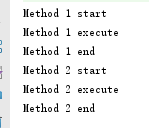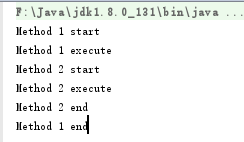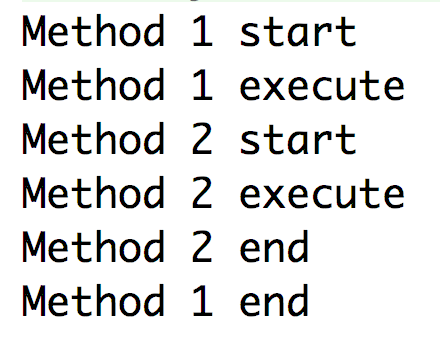1.为什么要使用synchronized
在并发编程中存在线程安全问题,主要原因有:1.存在共享数据 2.多线程共同操作共享数据。关键字synchronized可以保证在同一时刻,只有一个线程可以执行某个方法或某个代码块,同时synchronized可以保证一个线程的变化可见(可见性),即可以代替volatile。
2.实现原理
synchronized可以保证方法或者代码块在运行时,同一时刻只有一个方法可以进入到临界区,同时它还可以保证共享变量的内存可见性
3.synchronized的三种应用方式
Java中每一个对象都可以作为锁,这是synchronized实现同步的基础:
普通同步方法(实例方法),锁是当前实例对象 ,进入同步代码前要获得当前实例的锁静态同步方法,锁是当前类的class对象 ,进入同步代码前要获得当前类对象的锁同步方法块,锁是括号里面的对象,对给定对象加锁,进入同步代码库前要获得给定对象的锁。
4.synchronized的作用
Synchronized是Java中解决并发问题的一种最常用最简单的方法 ,他可以确保线程互斥的访问同步代码
5.举栗子
**一、synchronized作用于实例方法**
①多个线程访问同一个对象的同一个方法
|
1
2
3
4
5
6
7
8
9
10
11
12
13
14
15
16
17
18
19
20
21
22
23
24
25
26
27
|
public class synchronizedTest implements Runnable { //共享资源 static int i =0; /** * synchronized 修饰实例方法 */ public synchronized void increase(){ i++; } @Override public void run(){ for (int j =0 ; j<10000;j++){ increase(); } } public static void main(String[] args) throws InterruptedException { synchronizedTest test = new synchronizedTest(); Thread t1 = new Thread(test); Thread t2 = new Thread(test); t1.start(); t2.start(); t1.join(); t2.join(); System.out.println(i); }} |
结果:

分析:当两个线程同时对一个对象的一个方法进行操作,只有一个线程能够抢到锁。因为一个对象只有一把锁,一个线程获取了该对象的锁之后,其他线程无法获取该对象的锁,就不能访问该对象的其他synchronized实例方法,但是可以访问非synchronized修饰的方法
②一个线程获取了该对象的锁之后,其他线程来访问其他synchronized实例方法现象 举栗
|
1
2
3
4
5
6
7
8
9
10
11
12
13
14
15
16
17
18
19
20
21
22
23
24
25
26
27
28
29
30
31
32
33
|
public class SynchronizedTest { public synchronized void method1() { System.out.println("Method 1 start"); try { System.out.println("Method 1 execute"); Thread.sleep(3000); } catch (InterruptedException e) { e.printStackTrace(); } System.out.println("Method 1 end"); } public synchronized void method2() { System.out.println("Method 2 start"); try { System.out.println("Method 2 execute"); Thread.sleep(1000); } catch (InterruptedException e) { e.printStackTrace(); } System.out.println("Method 2 end"); } public static void main(String[] args) { final SynchronizedTest test = new SynchronizedTest(); new Thread(test::method1).start(); new Thread(test::method2).start(); }} |
结果:

分析:可以看出其他线程来访问synchronized修饰的其他方法时需要等待线程1先把锁释放
③一个线程获取了该对象的锁之后,其他线程来访问其他非synchronized实例方法现象 举栗
去掉②中方法二的synchronized
|
1
2
3
4
5
6
7
8
9
10
11
12
13
14
15
16
17
18
19
20
21
22
23
24
25
26
27
28
29
30
31
32
|
public class SynchronizedTest { public synchronized void method1() { System.out.println("Method 1 start"); try { System.out.println("Method 1 execute"); Thread.sleep(3000); } catch (InterruptedException e) { e.printStackTrace(); } System.out.println("Method 1 end"); } public void method2() { System.out.println("Method 2 start"); try { System.out.println("Method 2 execute"); Thread.sleep(1000); } catch (InterruptedException e) { e.printStackTrace(); } System.out.println("Method 2 end"); } public static void main(String[] args) { final SynchronizedTest test = new SynchronizedTest(); new Thread(test::method1).start(); new Thread(test::method2).start(); }} |
结果:

分析:当线程1还在执行时,线程2也执行了,所以当其他线程来访问非synchronized修饰的方法时是可以访问的
④当多个线程作用于不同的对象
|
1
2
3
4
5
6
7
8
9
10
11
12
13
14
15
16
17
18
19
20
21
22
23
24
25
26
27
28
29
30
31
32
33
34
|
public class SynchronizedTest { public synchronized void method1() { System.out.println("Method 1 start"); try { System.out.println("Method 1 execute"); Thread.sleep(3000); } catch (InterruptedException e) { e.printStackTrace(); } System.out.println("Method 1 end"); } public synchronized void method2() { System.out.println("Method 2 start"); try { System.out.println("Method 2 execute"); Thread.sleep(1000); } catch (InterruptedException e) { e.printStackTrace(); } System.out.println("Method 2 end"); } public static void main(String[] args) { final SynchronizedTest test1 = new SynchronizedTest(); final SynchronizedTest test2 = new SynchronizedTest(); new Thread(test1::method1).start(); new Thread(test2::method2).start(); }} |
结果:

分析:因为两个线程作用于不同的对象,获得的是不同的锁,所以互相并不影响
**此处思考一个问题:为什么分布式环境下synchronized失效?如何解决这种情况?
****二、synchronized作用于静态方法**
|
1
2
3
4
5
6
7
8
9
10
11
12
13
14
15
16
17
18
19
20
21
22
23
24
25
|
public class synchronizedTest implements Runnable { //共享资源 static int i =0; /** * synchronized 修饰实例方法 */ public static synchronized void increase(){ i++; } @Override public void run(){ for (int j =0 ; j<10000;j++){ increase(); } } public static void main(String[] args) throws InterruptedException { Thread t1 = new Thread(new synchronizedTest()); Thread t2 = new Thread(new synchronizedTest()); t1.start(); t2.start(); t1.join(); t2.join(); System.out.println(i); } |
结果:

分析:由例子可知,两个线程实例化两个不同的对象,但是访问的方法是静态的,两个线程发生了互斥(即一个线程访问,另一个线程只能等着),因为静态方法是依附于类而不是对象的,当synchronized修饰静态方法时,锁是class对象。
**三、synchronized作用于同步代码块**
为什么要同步代码块呢?在某些情况下,我们编写的方法体可能比较大,同时存在一些比较耗时的操作,而需要同步的代码又只有一小部分,如果直接对整个方法进行同步操作,可能会得不偿失,此时我们可以使用同步代码块的方式对需要同步的代码进行包裹,这样就无需对整个方法进行同步操作了。
|
1
2
3
4
5
6
7
8
9
10
11
12
13
14
15
16
17
18
19
20
21
22
23
|
public class synchronizedTest implements Runnable { static synchronizedTest instance=new synchronizedTest(); static int i=0; @Override public void run() { //省略其他耗时操作.... //使用同步代码块对变量i进行同步操作,锁对象为instance synchronized(instance){ for(int j=0;j<10000;j++){ i++; } } } public static void main(String[] args) throws InterruptedException { Thread t1=new Thread(instance); Thread t2=new Thread(instance); t1.start(); t2.start(); t1.join(); t2.join(); System.out.println(i); }} |
结果:

分析:将synchronized作用于一个给定的实例对象instance,即当前实例对象就是锁对象,每次当线程进入synchronized包裹的代码块时就会要求当前线程持有instance实例对象锁,如果当前有其他线程正持有该对象锁,那么新到的线程就必须等待,这样也就保证了每次只有一个线程执行i++;操作。当然除了instance作为对象外,我们还可以使用this对象(代表当前实例)或者当前类的class对象作为锁,如下代码:
|
1
2
3
4
5
6
7
8
9
10
11
12
13
|
//this,当前实例对象锁synchronized(this){ for(int j=0;j<1000000;j++){ i++; }}//class对象锁synchronized(AccountingSync.class){ for(int j=0;j<1000000;j++){ i++; }} |
下一篇将深入介绍Synchronized的实现原理
到此这篇关于Java Synchronized的使用详解的文章就介绍到这了,更多相关Java Synchronized使用内容请搜索服务器之家以前的文章或继续浏览下面的相关文章希望大家以后多多支持服务器之家!
原文链接:https://blog.csdn.net/zjy15203167987/article/details/82531772











